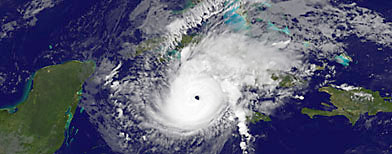 The 2010 Atlantic hurricane season will produce an above-average eight hurricanes, four of them major, posing a heightened threat to the U.S. coastline, the Colorado State University hurricane forecasting team predicted on Wednesday.
The 2010 Atlantic hurricane season will produce an above-average eight hurricanes, four of them major, posing a heightened threat to the U.S. coastline, the Colorado State University hurricane forecasting team predicted on Wednesday.
In its second forecast in four months for the 2010 season, the leading storm research team founded by hurricane forecast pioneer William Gray said the six-month season beginning on June 1 would likely see 15 named tropical storms.
The team forecast a 69 percent chance of at least one major hurricane making landfall on the U.S. coastline in 2010, compared with a long-term average probability of 52 percent.
Major hurricanes pack powerful sustained winds of at least 111 miles per hour (178 km per hour).
For the Gulf Coast, from the Florida Panhandle west to Brownsville, Texas, including the Gulf of Mexico oil patch, the probability of a major hurricane making landfall was seen at 44 percent versus a long-term average of 30 percent, the Colorado State University team said.
“While patterns may change before the start of the hurricane season, we believe current conditions warrant concern for an above-average season,” Gray said in a statement.
An average Atlantic season has about 10 tropical storms, of which six become hurricanes.
The Colorado State University team also predicted a 58 percent chance of a major hurricane tracking into the Caribbean, where Haiti is vulnerable after a devastating January 12 earthquake that left more than a million people homeless.
‘EXTREME’ SEASON FEARED
The earlier forecast in December by Gray’s team had already predicted an “above-average” season producing 11 to 16 tropical storms, including six to eight hurricanes. It had said three to five of next year’s storms would become “major” hurricanes of Category 3 or higher on the Saffir-Simpson intensity scale.
Another forecaster, AccuWeather.com, last month also forecast a potentially “extreme” hurricane season this year, with “above-normal threats” to the U.S. coastline.
AccuWeather said five hurricanes, two or three of them major, were expected to strike the U.S. coast, forming out of an expected 16 to 18 tropical storms, almost all of them in the western Atlantic or Gulf of Mexico.
The 2009 season ended November 30 had only nine storms, including three hurricanes, and was the quietest since 1997 due in part to El Nino, the eastern Pacific warm water phenomenon that tends to suppress Atlantic hurricanes.
But Phil Klotzbach, lead forecaster with the Colorado State team — whose research is followed closely by energy and commodity markets — said El Nino was expected to dissipate fully by the start of this year’s storm season.
“The dissipating El Nino, along with the expected anomalously warm Atlantic ocean sea surface temperatures, will lead to favorable dynamic and thermodynamic conditions for hurricane formation and intensification,” said Klotzbach.
The Colorado State University team has repeatedly cautioned that extended-range forecasts for hurricane activity are imprecise and can often miss the mark.
The university team originally expected the 2009 season to produce 14 tropical cyclones, of which seven would become hurricanes. But the season, which ended on November 30 and was the quietest since 1997, had only nine storms, including three hurricanes.
Did you know that if you subscribe to our website, you will receive email notifications whenever content changes or new content is added.
1. Enter your e-mail address below and click the Sign Me Up button.
2. You will receive an email asking you to confirm your intention of subscribing to our site.
3. Click the link in the email to confirm. That’s all there is to it! Note: if you wish to unsubscribe from our site, click the unsubscribe link at the bottom of the email you received.
Then indicate you no longer wish to receive our emails.
Thank You
Prisonbreakfreak.com Team